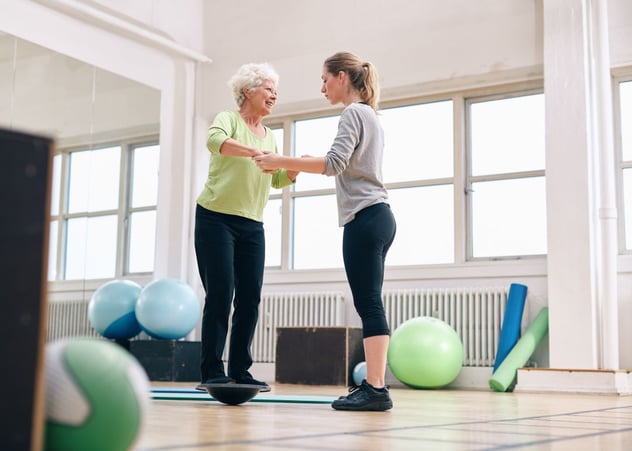
If you suffer from a stroke, Parkinson’s Disease, Multiple Sclerosis, or any other condition that affects your ability to walk, you may be referred for balance and gait training as part of your physical rehabilitation. Let’s examine what you need to know about gait training, balance exercises, and how they help patients to gain improved mobility and a better quality of life.
What is Balance and Gait Training?
Balance and gait training exercises form a part of physical therapy for patients with injuries affecting their lower extremities or neuromuscular conditions. Balance and gait training exercises focus primarily on improving your ability to walk. Your “gait” is simply your manner of walking. A “gait cycle” is the process of lifting your foot off the ground, stepping forward, landing on your foot, and lifting it again.
Typically, gait training will involve a combination of supervised walking on a treadmill, possibly with a harness to keep you supported, and a series of exercises that will help improve your mobility and strength. Your balance and gait training program will be customized to your specific needs and diagnosis.
For improved mobility, you may be advised to work on the range of motion in your leg joints, with exercises such as hamstring stretches, hip rotations, or ankle pumps. For strength training, you may work with a physical therapist to practice stepping over progressively larger objects or up and down steps, sitting down, standing up, and lifting your legs.
Balance is also crucial for walking – after all, when you’re walking, you spend nearly half the time standing on one leg. To build up your balance, you may work on standing on one leg and build up to standing on one leg while on an unsteady surface, or even with your eyes closed.
Depending on your level of mobility, you may need an assistive device to help you walk, such as a walker, cane or crutches. If you do need a device, your physical therapist will be able to help advise you on the best option for you, set the device up correctly at the right height, and help you use it correctly.
You may also find that parallel bars are helpful during gait training. These strong bars are set at waist height, enabling you to support some of your body weight with your arms while you work on your gait.
What are the Benefits of Balance and Gait Training?
Balance and gait training exercises can be hard work, especially if you’ve been immobile for a while. However, it can also be immensely beneficial and have a major impact on your quality of life. In particular, gait training exercises can improve:
1. Muscle Tone and Flexibility
Conditions like stroke, Multiple Sclerosis and spinal cord injuries not only affect your ability to walk; they can also cause your muscles to tighten and lock in place. This may be very painful or cause uncontrollable spasms. Gait training can be helpful in increasing mobility in spastic muscles, building muscle tone, and potentially reducing pain.
2. Range of Motion
As well as giving you more flexibility in the muscles of your legs, gait training may also help increase the range of motion of your joints. Working slowly and carefully with your physical therapist, you should begin to see that you have more movement in your knees, hips and ankles, making standing and walking progressively easier.
3. Strength
Gait exercises are perfectly designed to help build up the muscles in your legs, core, and back, enabling you to regain maximum mobility and potentially begin to stand and walk again unassisted. By repeating strength training exercises, your muscle tone will increase, and you will develop muscle memory, build endurance, and retrain your legs.
4. Balance and Coordination
By practicing balance and gait training exercises, you should become more comfortable balancing on your own, gaining increased confidence as you move through your day. Gait training should help you increase your ability to hold your own bodyweight, shift your weight from side to side, and remain consistently stable. As well as making it easier to balance, you should also notice that your posture improves during your gait training. Balance training will also make it less likely that you will risk a fall and avoid any resulting injuries.
How Can Balance and Gait Training Help Patients with Multiple Sclerosis?
Multiple Sclerosis (MS) is a severe autoimmune disease that affects the central nervous system. Symptoms include muscle weakness, sensory issues, and muscle spasticity. MS may also cause gait ataxia – a term used to describe reduced coordination with voluntary muscle movements. In MS, this may cause reduced walking speed, lack of stability when walking, poor balance, and a swaying head or torso to compensate for the underlying gait issues.
Balance and gait training exercises can be very helpful for patients with MS because it targets the underlying issues that cause the gait ataxia, rather than the compensatory walking patterns that MS patients frequently develop over time.
Gait training can help improve the positioning of the muscles, strengthen surrounding muscles, improve joint compressions, and reduce muscle tightness and spasticity. It can also help improve joint range of motion, especially in the ankle joints, ideally avoiding compensatory gait issues. According to research published in the International Journal of MS Care, gait training can also help increase muscle strength. As a result of improving mobility in patients with MS, balance and gait training exercises can have a significant positive effect on their mood and quality of life.
How Does Gait Training Support Management of Parkinson’s Disease (PD)?
Parkinson’s Disease is a progressive disease caused by a lack of dopamine production, resulting in deterioration of the nervous system. Parkinson’s patients experience muscle tremors and shakes, rigidity, and bradykinesia (slowness of movement). As the disease progresses, many patients with PD experience increasing problems with walking, including decreased step length, a shuffling manner of walking, less coordination, and an increased risk of falling.
Progressive strength training, stretching, flexibility exercises, and relaxation training have all been shown to reduce gait issues in patients with Parkinson’s. Balance training can also help reduce falls in patients with PD and increase their confidence and quality of life. Treadmill training can also help people with Parkinson’s manage more than one task when walking. Research suggests that progressive resistance training may even slow down the rate of progression for PD.
Balance and gait training exercises can be highly effective, and they are a key component of physical therapy for many conditions, including Multiple Sclerosis and Parkinson’s Disease. To find out more about how Rehab Select approaches care for those suffering from neuromuscular disorders, please visit our website, or click here to contact us.





